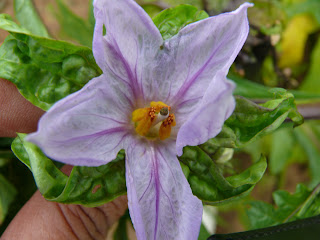B. K. Singh, S.
R. Sharma, Chandra Prakash, R. N. Barwal and M. R. Dhiman
ICAR News: A Science and Technology
Newsletter 17 (2): 2-3, 2011
E-mail: bksinghkushinagar@yahoo.co.in
Production
of deleterious reactive oxygen species (ROS) such as singlet oxygen (1O2),
superoxide radical (●O-2), hydrogen peroxide
(H2O2), hydroxyl ion (OH-) and free hydroxyl
radical (●OH) is one of the reasons for poor productivity and
quality of the harvest under stressful conditions in cabbage. Plants possess
well-developed defense systems against deleterious ROSs by limiting
their formation and by triggering for their removal. If ROSs are not neutralized,
they damage cells, causing susceptibility to biotic and abiotic stresses,
yellowing and senescence. Pre-mature senescence leads to loss of vigour, productivity
and quality of produce. Antioxidant enzymes- superoxide dismutase (SOD),
peroxidase (POX) and catalase (CAT)- have touted as beneficial for mitigating
effects of oxidative stresses induced by ROSs. SOD, localized in cytosol,
chloroplast, mitochondria and peroxisomes, accelerates the dismutation of ●O2-
to H2O2. POX, an iron heme protein, catalyses H2O2
reduction with a concurrent oxidation of a substrate, mostly located in
cell wall, and is involved in the oxidation of phenol compounds towards lignin
synthesis. CAT also catalyses H2O2 reduction to water and
molecular oxygen, and is localized in mitochondria and peroxisomes, and absent
in chloroplast. This study determined variability for enzymes SOD, POX and CAT
activities, and their inheritance was studied in the cabbage samples harvested
at the fresh marketable stage, frozen immediately in liquid nitrogen and placed
at -80 0C for assay. Enzymatic antioxidant activities showed 1.6,
12.8, and 18.2-fold difference for SOD, POX and CAT, respectively. Red Cabbage, 83-2, KIRC-1-1, ARU Glory, Kinner Red,
MR-1, AC-208, Red Rock Mammoth, KIRC-8 and KIRC-1A showed higher activity of
antioxidant enzymes. All enzymatic antioxidants expressed high heritability
along with low genetic advance as percentage of mean indicated the predominance
of non-additive genes, and provide good prospects for hybridization and hybrid
breeding. The results indicate that breeding of antioxidant potential cultivars
will enhance the stress tolerance ability of cabbage and will result in healthy
plant stand, and thus eventually mitigate climate change effects in cabbage
cultivation.







